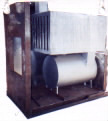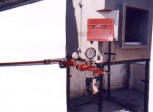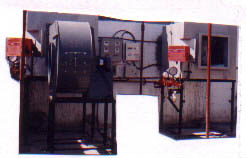Bin Dryer
Bulletin
Sakav is a commercial quality bin dryer used to dry products requiring long dwell times. The advanced design of Sakav Bin Dryers maximizes production and minimizes down time, by affording discreet control over the process air temperature, air velocity, and humidity, not as a group, but to each individual bin. The results are spectacular, often five bins do the work of eight standard units. Dehydration is virtually continuous, with three bins running, while the fourth bin is filling, and the fifth bin is discharging dried product
COUNTER FLOW DRYING PRINCIPLE:
- Wet product enters at top of dryer and exits at bottom.
- Hot, dry air enters at bottom of dryer, recirculates through various decks (reheated as necessary), and exits at top.
- This means that driest product contacts driest air, and wettest air contacts wettest product, which is most efficient airflow.
PRODUCT HANDLING FEATURES:
- Each deck retains product for a timed interval, then gravity transfers, or “cascades” product to deck below as a batch.
- This process repeats until products pass completely through dryer in a very controlled manner.
- Product decks incorporate a simple, pivoting tray design, operated by hydraulic cylinder. Trays pivot 90°, dumping entire product bed instantly.
- Decks are dumped in sequence, starting at bottom. This means that each deck is empty and closed before next product falls onto it, thus assuring product separation.
- Top (accumulation) deck includes a suitable product spreader to ensure a uniform bed depth. One version features a rotating spout and rake spreader that levels bed. Other versions are available.
- Rotary airlock at product inlet to compensate for negative air pressure.
- All decks will have same bed depth and retention time, except for top one. Bed depth and retention time for top (accumulation) deck will vary, since it is continuously filling.
- A minimum of five dryer decks (one accumulation, and two temperature zones) is required to ensure minimum moisture variation
AIR FLOWS:
- Air direction alternates up and down between decks.
- A temperature zone consists of two decks. There are two recirculation fans and one heating system per zone. The upper deck of the pair has the fans. The lower deck has the heating system.
- Recirculated air works its way up dryer zones, using settling chamber as an interconnection duct, and is exhausted at top. This means that each zone recirculates only as much air as required, and is independent of other zones.
- Recirculated air enters through ducts on both sides. These ducts feature splitter vanes to improve uniformity of airflow.
- Recirculated air on both sides of back plenum passes through dampers (optionally motorized). This permits regulation of air velocity through product.
- Internal ducting maintains high air velocity, keeping any fines in suspension. As air passes through settling chamber, air velocity is reduced significantly, causing any fines to fall out of suspension. Fines fall to bottom of settling chamber, where a single fines auger removes them.
- Baffles in settling chamber prevent falling fines from zones above being drawn into recirculation ducts of lower zones.
- Top (accumulation) deck has small quantity of ambient air drawn down through it to eliminate possible condensation, without significant drying of product. Drying on this deck is minimized because retention time varies on this deck as it fills.
- If integral cooler is included, cooler air is then used as dryer makeup air to increase efficiency. If not, outside air or air from separate cooler is added to bottom zone.
- If more than one cooler deck is used, cooler air flows through all cooler decks, from bottom to top. This minimizes cooler air, thus not exceeding dryer requirement for makeup air. When necessary, excess cooler air can be exhausted directly.
- Each zone can have its own temperature and air velocity, independent of other zones
HEATING SYSTEM:
- Dryers may be gas fired or steam heated. Other heat sources are possible.
- Fans and burners (or steamcoils) are housed in insulated back plenum
MAINTENANCE ACCESS:
- Dryer is designed to support catwalks all around dryer at each zone.
- Hinged access door on front of each deck provides easy access to product area.
- Thermal insulated window on each deck permits visual inspection of product during drying.
- Hinged side doors provide full access to side ducts for maintenance.
- Hinged doors on back side permit access inside internal ducting and fines settling chamber for maintenance.
- Space around internal ducting inside back plenum is accessible through doors for maintenance. Grated platform and access ladder is included inside each zone. This space is accessible during operation.
- Removable panels permit access to fan wheels. Fan drives and bearings are mounted externally.
- Heating system valves and controls are located outside of dryer for easy maintenance.
CONTROLS :
- Dryer/Cooler is PLC controlled. Complete computer control is available as an option, tying it into extruder controls. Feed forward moisture control is also an option.
- Hydraulic cylinders that operate dump mechanism on each deck control tray dump cycling. These are controlled by PLC timers that switch solenoid valves connected to cylinders.
- Bed depth level sensors are included on top (accumulation) deck to alarm if bed depth and retention times are not synchronized.
- Rake spreader features remote controlled lifting device with position transducers, to precisely control bed depth from PLC as an option.
- Temperature zones consist of two decks. Each zone includes RTD temperature sensor and PID type controller that adjusts valve in gas or steam line for that zone.
- Pressure transducers measure pressure drop through each bed. Additional devices measure air velocity in each zone. This is used to control air velocity through product.
- Fittings are included for installation of additional RTD’s at each deck and in exhaust air for additional temperature monitoring if required.



